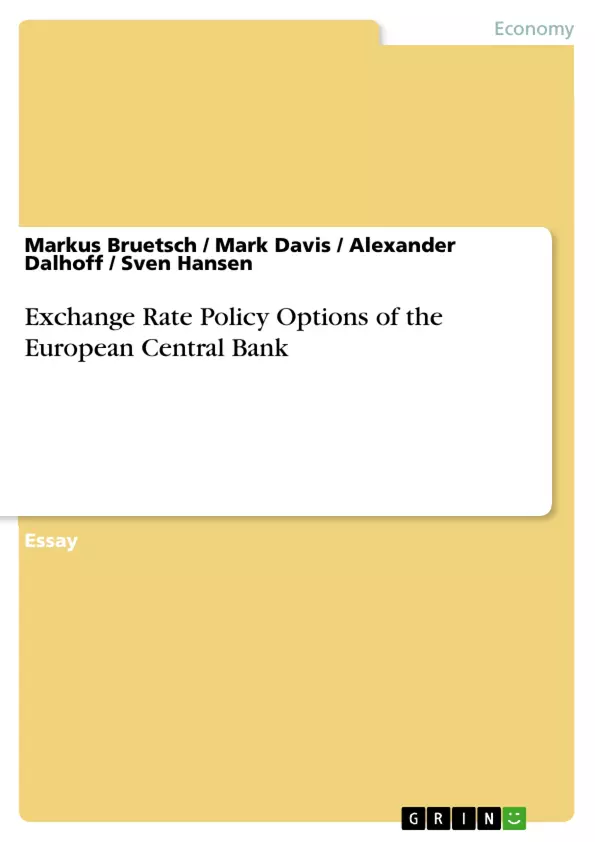Since the euro has been introduced as the common currency of the
European Monetary Union (EMU) exchange rate policy-making has not
been noticeably mentioned on the agenda of the European Central Bank
(ECB). This work examines and explains the development of the euro
since its introduction in 1999. A discussion of possible exchange rate
regimes, their impacts on domestic and international trade and living
standards, as well as a brief introduction on market intervention will put
forward a recommendation to the ECB for its future exchange rate policy.
Since most of the past currency crises emerged from monetary systems of
fixed exchange rates, empirical data suggests a non fixed external regime
to the EMU, even more since this allows a range of steering and
counteracting opportunities.
Following the Keynesian monetary theory, the forces of supply and
demand are not always sufficient to guarantee a stable and sound
economic environment for successful trade and growth. Therefore a free
floating system of exchange rates might not be the right way for the ECB
to follow its aim of price stability and competitiveness in a highly
integrated area as the EU.
We recommend employing an external managed floating system at a
reasonably high level of currency value, i.e. purchasing power, depending
on the situation of employment and export-import balance. The ECB
should carefully carry out market interventions, limited by international
exchange rate agreements, e.g. by the G-10 Nations summits.
Inhaltsverzeichnis (Table of Contents)
- I. Executive summary
- 1. Introduction
- 2. Development of the euro since 1999
- 2.1 The path of the euro
- 2.2 Explanations of the weakness of the euro
- 3. Exchange rate policy-making in the EMU
- 3.1 Floating exchange rates
- 3.2 Managed floating exchange rates
- 3.3 Fixed Exchange rates
- 3.4 Fixed Rates with Bands
- 4. Keynes vs. Neoclassic – Market interventions
- 4.1 Options for market intervention
- 5. Recommendation for a future exchange rate policy
- II. Bibliography
Zielsetzung und Themenschwerpunkte (Objectives and Key Themes)
This paper examines the development of the euro since its introduction in 1999, focusing on the potential exchange rate regimes and their impact on domestic and international markets and living standards. It also explores the role of market intervention in shaping exchange rate policies. The paper concludes with a recommendation for the European Central Bank's future exchange rate policy.
- The development of the euro since 1999
- Analysis of various exchange rate regimes
- Impact of exchange rate regimes on domestic and international markets
- The role of market intervention in exchange rate policy
- Recommendation for a future exchange rate policy for the ECB
Zusammenfassung der Kapitel (Chapter Summaries)
- Executive Summary: The paper argues that the European Central Bank should employ an external managed floating system for the euro, balancing price stability and competitiveness in the EU. This is a key element of the paper's overarching recommendation.
- Introduction: This chapter introduces the paper's focus on analyzing the euro's path since 1999 and exploring different exchange rate regimes and their economic effects. It also outlines the discussion of market interventions and the final recommendation for the ECB's future policy.
- Development of the euro since 1999: This chapter describes the two-step introduction of the euro, first as a common transaction currency in 1999 and then as real money in 2002. It also examines the euro's value against the US dollar, Japanese yen, and British pound sterling since its inception.
- The path of the euro: This chapter explores the euro's initial predicted strength and its subsequent decline, highlighting the discrepancy between expectations and reality. It also analyzes the euro's fluctuations in value against the US dollar.
Schlüsselwörter (Keywords)
The primary focus of this paper is on the euro, its development, and the various exchange rate regimes, including floating, managed floating, fixed, and fixed with bands. The analysis also incorporates the impact of these regimes on economic indicators such as domestic and international markets, living standards, and price stability. Additionally, the paper explores the role of market intervention in influencing exchange rate policies.
- Arbeit zitieren
- Markus Bruetsch (Autor:in), Mark Davis (Autor:in), Alexander Dalhoff (Autor:in), Sven Hansen (Autor:in), 2003, Exchange Rate Policy Options of the European Central Bank, München, GRIN Verlag, https://www.hausarbeiten.de/document/14848


